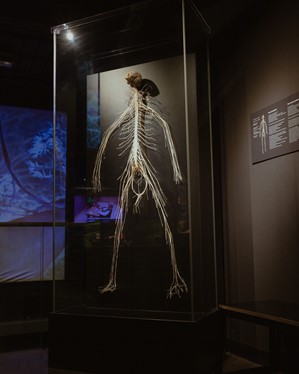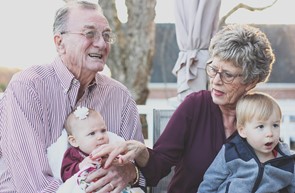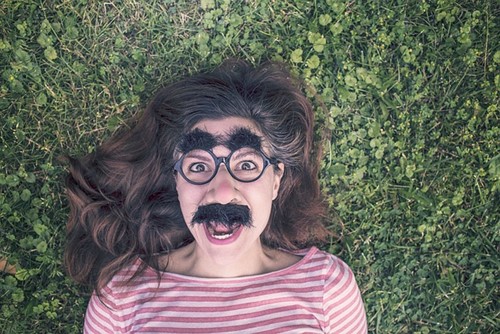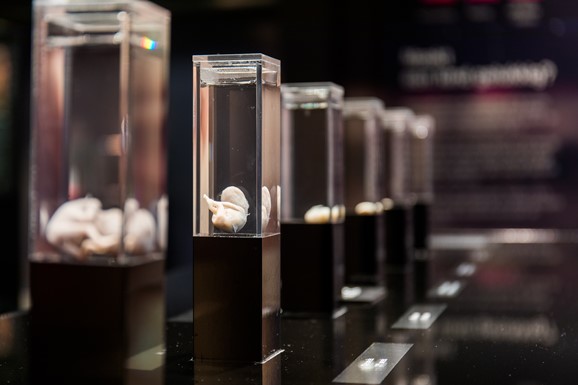From the moment you were conceived, your cells have been doing mathematics – dividing, multiplying – creating copies of themselves. After a certain age, you are done getting taller. How does this happen and are there parts of the body that keep growing? We take a closer look at the development of the human body, how we evolve from embryos to slouching grandpa’s.
How do we grow?
The cells that make up our body are constantly changing and developing. When your body is getting bigger, your cells grow and divide into two new cells. This process is called cell division. Children have growth plates at the end of their bones, the cells in those plates multiply which makes the bones longer.
Which factors decide how much we grow?
There are three key players into the development of your body: genetics, nutrition and hormones.
 Genetics
Genetics
The mix of what your parents and grandparents have given you contain the manual of how your body should develop. Your genes determine what you will look like, your height, muscle mass, bone structure and more.
Nutrition
what goes into your body is essential for growth. Enough variety with building blocks like proteins, carbohydrates, good fats, vitamins and minerals. Sufficient food with all the nutrients is essential for getting taller.
Hormones
The growth of different body parts is regulated by different hormones. For example, growth hormone stimulates the growth of bones and muscles. Testosterone stimulates the growth of muscle mass and bone density.
The growth cycle
From infancy, childhood, adolescence (puberty) to shrinking?
Infancy – from 0 to 1 years
A new human starts being formed when an egg and sperm come together in the womb and start the process of cell division. The stem cells create specialized cells and build a foundation for tissues and organs to grow. Physically, heads are large in proportion to the rest of the body. Average birth weight varies from about 2.5 to 4.5 kg (5.5 to 10 pounds), and length varies from 45.7 to 53.3 cm (18 to 21 inches).
Childhood – from ages 1-2 to 12-13
During childhood, the body creates a lot of growth hormone, which is important for making the whole body grow. This hormone helps bones get longer, cells multiply, and muscles develop. The bodies system manages all of this, making sure that each stage of growing happens the way it's supposed to according to our genes.
Adolescence - on average from ages 10 to 19
Brace yourself, puberty is coming. This is a transitional period that happens with a surge of hormones. In this period your body grows into an adult, which often comes with a growth spurt included. This phenomenon occurs for girls between the ages of 8 and 13 and ages 10 to 15 for boys. This is the time where you can seem to be eating whatever, because your body needs a lot of energy to grow.
After this very important and, emotional, fase of the human growth, you have transformed from a child into an adult. Well, height wise at least. After puberty you are almost done growing in centimeters. This is because the growth plates at the end of our bones fuse together during puberty. When this has happened, your cells can not produce new bone. However, in some areas it is possible to grow slightly like in the shoulders and hips.
Adulthood
This is the period where your body has fully developed, physical and intellectual maturity. The height may be at its final stage, there is still a continues process going on for cellular turnover. Cognitive and emotional development stabilizes. There is a focus of the body of maintain over health. Eventually, the bodies capabilities start to decrease again.
When do you stop growing?
The skeleton is fully developed and the growth plates have fused closed a couple years after puberty. Without room in the growth plates for the cells to divide, it is not possible for the bones to grow.
Lengthwise you may have stopped growing, you can still grow your body in width. By gaining weight you add fat cells to your body. Or you can grow your muscles by weight lifting. During your workout you tear and make tiny cuts in your muscles. To recover those tears, your body produces extra cells, which will eventually make your muscles bigger. Read more about muscle growth in our blog.
 Why do old people shrink?
Why do old people shrink?
As people age, some of the developments the body are taking steps back. Hard of hearing, bad eye sight, being more forgetful and getting tinier. This can be due to a decline in bone density, this causes the bones to compress. Age-related loss of muscle mass weakens spinal muscles, and arthritis can affect joint flexibility, both contributing to alterations in height. Some of it is just a natural part of getting older, but staying active, eating well, and getting proper medical care can help keep you healthy as you age.
Are there parts of your body that keep growing?
Nose and ears
Your nose and ears consist mostly of cartilage. Unlike your bones, cartilage does not stop growing. Overtime, they get slightly bigger.
With gravity pulling down our body, the parts that are sticking out elongate over time. The earlobes get stretched out and the nose can drop down slightly.

Hair growth and nail growth
Your hair and nails continue to grow throughout your life. They both grow from a matrix, where new cells are pushing the old ones out. These old cells get further removed from the blood supply and start to form keratin and harden. This is what you see on the surface.
Studies are inconclusive as to if hair and nail vitamins can actually support the growth. If you are not getting enough nutrition and vitamins in your diet the gummies will be beneficial. Being healthy and eating a healthy diet is the best way to stimulate growth.
There is a myth that the hair and fingernails continue to grow after you have passed away. This is not true. As we have learned, our body grows through cell division. This only takes place when the cells are supplied with energy, coming from the oxygen we breathe. Nails and hair on a dead body appear to be longer because the skin around them retracts.


